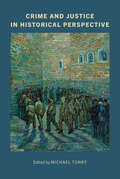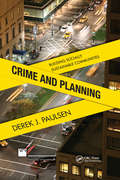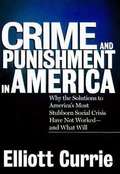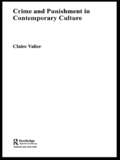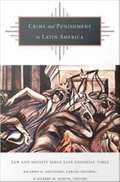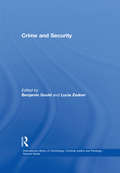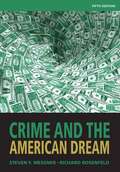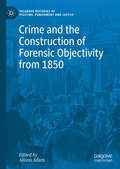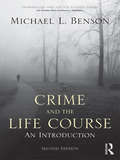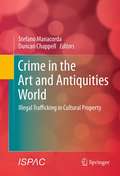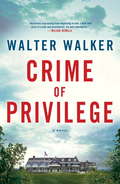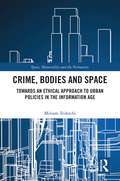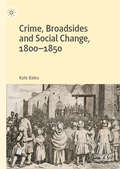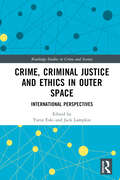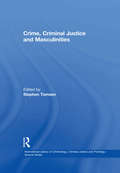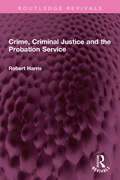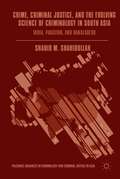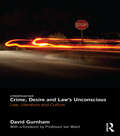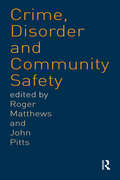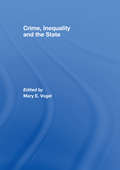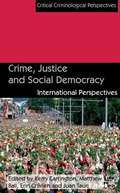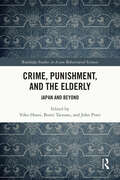- Table View
- List View
Crime and Justice, Volume 53: Crime and Justice in Historical Perspective (Crime and Justice: A Review of Research #53)
by The University of Chicago PressPresents cutting-edge scholarship by preeminent criminology scholars. Since 1979, Crime and Justice has presented a review of the latest international research, providing expertise to enhance the work of sociologists, psychologists, criminal lawyers, justice scholars, and political scientists. The series explores a full range of issues concerning crime, its causes, and its cures. In both the review and the thematic volumes, Crime and Justice offers an interdisciplinary approach to address core issues in criminology.
Crime and Planning: Building Socially Sustainable Communities
by Ph.D., Derek PaulsenThe form and layout of a built environment has a significant influence on crime by creating opportunities for it and, in turn, shaping community crime patterns. Effective urban planners and designers will consider crime when making planning and design decisions. A co-publication with the American Planning Association, Crime and Planning:
Crime and Punishment in America
by Elliott CurrieThere are five times as many Americans behind bars today as in 1970. The national incarceration rate in 1997 was twice that in 1985. California's prison system has become the third largest in the world.
Crime and Punishment in Contemporary Culture (International Library of Sociology)
by Claire ValierToday, questions about how and why societies punish are deeply emotive and hotly contested. In Crime and Punishment in Contemporary Culture, Claire Valier argues that criminal justice is a key site for the negotiation of new collective identities and modes of belonging. Exploring both popular cultural forms and changes in crime policies and criminal law, Valier elaborates new forms of critical engagement with the politics of crime and punishment. In doing so, the book discusses:· Teletechnologies, punishment and new collectivities· The cultural politics of victims rights· Discourses on foreigners, crime and diaspora· Terror, the death penalty and the spectacle of violence.Crime and Punishment in Contemporary Culture makes a timely and important contribution to debate on the possibilities of justice in the media age.
Crime and Punishment in Latin America: Law and Society since Late Colonial Times
by Gilbert M. Joseph Ricardo D. Salvatore Carlos AguirreCrowning a decade of innovative efforts in the historical study of law and legal phenomena in the region, Crime and Punishment in Latin America offers a collection of essays that deal with the multiple aspects of the relationship between ordinary people and the law. Building on a variety of methodological and theoretical trends--cultural history, subaltern studies, new political history, and others--the contributors share the conviction that law and legal phenomena are crucial elements in the formation and functioning of modern Latin American societies and, as such, need to be brought to the forefront of scholarly debates about the region's past and present. While disassociating law from a strictly legalist approach, the volume showcases a number of highly original studies on topics such as the role of law in processes of state formation and social and political conflict, the resonance between legal and cultural phenomena, and the contested nature of law-enforcing discourses and practices. Treating law as an ambiguous and malleable arena of struggle, the contributors to this volume--scholars from North and Latin America who represent the new wave in legal history that has emerged in recent years-- demonstrate that law not only produces and reformulates culture, but also shapes and is shaped by larger processes of political, social, economic, and cultural change. In addition, they offer valuable insights about the ways in which legal systems and cultures in Latin America compare to those in England, Western Europe, and the United States. This volume will appeal to scholars in Latin American studies and to those interested in the social, cultural, and comparative history of law and legal phenomena. Contributors. Carlos Aguirre, Dain Borges, Lila Caimari, Arlene J. Daz, Luis A. Gonzalez, Donna J. Guy, Douglas Hay, Gilbert M. Joseph, Juan Manuel Palacio, Diana Paton, Pablo Piccato, Cristina Rivera Garza, Kristin Ruggiero, Ricardo D. Salvatore, Charles F. Walker
Crime and Security (International Library Of Criminology, Criminal Justice And Penology - Second Ser.)
by Lucia Zedner Benjamin GooldThe pursuit of security is now central to the development of public policy and a driving force behind the spread of private policing. Just as new theoretical frameworks are needed to deal with the increasing tendency of crime control policies to focus on risk reduction, new forms of governance are also required to deal with the rapid growth of the private security industry. This volume brings together a wide range of contributions from leading scholars in the field and includes international and comparative perspectives on the challenges posed by the rise of the 'security society'.
Crime and the American Dream
by Richard Rosenfeld Steven F. MessnerHow has America's over-emphasis on the pursuit of materialistic gain contributed to the it's high rate of violent crime? CRIME AND THE AMERICAN DREAM, 5th Edition is an easy-to-understand book that attempts to answer that question using seminal criminological theory.
Crime and the Construction of Forensic Objectivity from 1850: Space, Media, Experts And Ethics (Palgrave Histories of Policing, Punishment and Justice)
by Alison AdamThis book charts the historical development of 'forensic objectivity' through an analysis of the ways in which objective knowledge of crimes, crime scenes, crime materials and criminals is achieved. Taking an interdisciplinary approach, with authors drawn from law, history, sociology and science and technology studies, this work shows how forensic objectivity is constructed through detailed crime history case studies, mainly in relation to murder, set in Scotland, England, Germany, Sweden, USA and Ireland. Starting from the mid-nineteenth century and continuing to the present day, the book argues that a number of developments were crucial. These include: the beginning of crime photography, the use of diagrams and models specially constructed for the courtroom so jurors could be ‘virtual witnesses’, probabilistic models of certainty, the professionalization of medical and scientific expert witnesses and their networks, ways of measuring, recording and developing criminal records and the role of the media, particularly newspapers in reporting on crime, criminals and legal proceedings and their part in the shaping of public opinion on crime. This essential title demonstrates the ways in which forensic objectivity has become a central concept in relation to criminal justice over a period spanning 170 years.
Crime and the Life Course
by Michael BensonIn recent years, the lifecourse perspective has become a popular theoretical orientation toward crime. Yet despite its growing importance in the field of criminology, most textbooks give it only cursory treatment. Crime and the Lifecourse: An Introduction by Michael L. Benson provides a comprehensive overview of contemporary research and theory on the life-course approach to crime. The book emphasizes a conceptual understanding of this approach. A special feature is the integration of qualitative and quantitative research on criminal life histories. This book: provides an overview of the life course approach and describes the major concepts and issues in lifecourse theory as it applies to criminology reviews evidence on biological and genetic influences on crime reviews research on the role of the family in crime and juvenile delinquency provides a detailed discussion of the criminological lifecourse theories of Moffitt, Hagan, Sampson and Laub, and others discusses the connections between youthful crime and adult outcomes in education, occupation, and marriage presents an application of the lifecourse approach to white-collar crime discusses how macro sociological and historical developments have influenced the shape of the lifecourse in American society as it relates to patterns in crime.
Crime in the Art and Antiquities World: Illegal Trafficking in Cultural Property
by Stefano Manacorda Duncan ChappellThe theft, trafficking, and falsification of cultural property and cultural heritage objects are crimes of a particularly complex nature, which often have international ramifications and significant economic consequences. Organized criminal groups of various types and origins are involved in these illegal acts. The book Crime in the Art and Antiquities World has contributions both from researchers specializing in the illegal trafficking of art, and representatives of international institutions involved with prevention and detection of cultural property-related crimes, such as Interpol and UNESCO. This work is a unique and useful reference for scholars and private and public bodies alike. This innovative volume also includes an Appendix of the existing legal texts, i.e. international treaties, conventions, and resolutions, which have not previously been available in a single volume. As anyone who has undertaken research or study relating to the protection of cultural heritage discovers one of the frustrations encountered is the absence of ready access to the multi- various international instruments which exist in the field. Since the end of the Second World War these instruments have proliferated, first in response to increasing recognition of the need for concerted multinational action to give better protection to cultural property during armed conflict as well as ensuring the repatriation of cultural property looted during such conflict. Thus the international community agreed in 1954 upon a Convention for the Protection of Cultural Property in the Event of Armed Conflict. That Convention, typically referred to as the Hague Convention of 1954, is now to be found reproduced in the Appendix to this book (Appendix I) together with 25 other important and diverse documents that we believe represent a core of the essential international sources of reference in this subject area. In presenting these documents in one place we hope that readers will now experience less frustration while having the benefit of supplementing their understanding and interpretation of the various instruments by referring to individual chapters in the book dealing with a particular issue or topic. For example, Chapter 9 by Mathew Bogdanos provides some specific and at times rather depressing descriptions of the application in the field of the Hague Convention 1954, and its Protocols (Appendices II and III), to the armed conflict in Iraq. Reference may also be had to the resolution of the UN Security Council in May 2003 (Appendix VI) urging Member States to take appropriate steps to facilitate the safe return of looted Iraqi cultural property taken from the Iraq National Museum, the National Library and other locations in Iraq. Despite such pleas the international antiquities market seems to have continued to trade such looted property in a largely unfettered manner, as demonstrated by Neil Brodie in Chapter 7. Fittingly, as referred to in the Preface to this book, the last document contained in the Appendix (Appendix 26) is the "Charter of Courmayeur", formulated at a ground breaking international workshop on the protection of cultural property conducted by the International Scientific and Professional Advisory Council (ISPAC) to the United Nations Crime Prevention and Criminal Justice Program in Courmayeur, Italy, in June 1992. The Charter makes mention of many of the instruments contained in the Appendix while also foreshadowing many of the developments which have taken place in the ensuing two decades designed to combat illicit trafficking in cultural property through international collaboration and action in the arena of crime prevention and criminal justice.
Crime of Aggression Library: A Commentary
by Stefan Barriga Claus KreßThe 2010 Kampala Amendments to the Rome Statute empowered the International Criminal Court to prosecute the 'supreme crime' under international law: the crime of aggression. This landmark commentary provides the first analysis of the history, theory, legal interpretation and future of the crime of aggression. As well as explaining the positions of the main actors in the negotiations, the authoritative team of leading scholars and practitioners set out exactly how countries have themselves criminalized illegal war-making in domestic law and practice. In light of the anticipated activation of the Court's jurisdiction over this crime in 2017, this work offers, over two volumes, a comprehensive legal analysis of how to understand the material and mental elements of the crime of aggression as defined at Kampala. Alongside The Travaux Préparatoires of the Crime of Aggression (Cambridge, 2011), this commentary provides the definitive resource for anyone concerned with the illegal use of force. The world's leading experts - from both the academy and the Kampala Conference negotiations - come together in these volumes to provide the definitive commentary on the international crime of aggression Situates the crime of aggression amendments to the Rome Statute within a wider historical, theoretical and political context Offers a wide-reaching analysis of legislation spanning several national jurisdictions, provides insightful policy assessments by representatives of key State actors, and comprehensively sets out the position of the crime under international law Comprehensively examines the elements of the crime, to assist practitioners and scholars in its interpretation
Crime of Privilege
by Walter WalkerIn the tradition of Scott Turow, William Landay, and Nelson DeMille, Crime of Privilege is a stunning thriller about power, corruption, and the law in America--and the dangerous ways they come together. A murder on Cape Cod. A rape in Palm Beach. All they have in common is the presence of one of America's most beloved and influential families. But nobody is asking questions. Not the police. Not the prosecutors. And certainly not George Becket, a young lawyer toiling away in the basement of the Cape & Islands district attorney's office. George has always lived at the edge of power. He wasn't born to privilege, but he understands how it works and has benefitted from it in ways he doesn't like to admit. Now, an investigation brings him deep inside the world of the truly wealthy--and shows him what a perilous place it is. Years have passed since a young woman was found brutally slain at an exclusive Cape Cod golf club, and no one has ever been charged. Cornered by the victim's father, George can't explain why certain leads were never explored--leads that point in the direction of a single family--and he agrees to look into it. What begins as a search through the highly stratified layers of Cape Cod society, soon has George racing from Idaho to Hawaii, Costa Rica to France to New York City. But everywhere he goes he discovers people like himself: people with more secrets than answers, people haunted by a decision years past to trade silence for protection from life's sharp edges. George finds his friends are not necessarily still friends and a spouse can be unfaithful in more ways than one. And despite threats at every turn, he is driven to reconstruct the victim's last hours while searching not only for a killer but for his own redemption.Advance praise for Crime of Privilege "Walter Walker's Crime of Privilege is a terrifically entertaining race of a read that also effortlessly manages to be jam-packed with intelligence, insight, morality, and heart. Top-notch and highly recommended!"--New York Times bestselling author John Lescroart "A stunning first legal thriller that is sure to get as much attention as John Grisham's The Firm and Scott Turow's Presumed Innocent . . . An outstanding crime story with spot-on characterization, a protagonist whose humiliating past compels sympathy, and a host of unexpected suspects. The novel's moral complexity will appeal to readers who enjoyed works as diverse as Tom Wolfe's Bonfire of the Vanities, Nelson DeMille's The Gold Coast, and any number of contemporary thrillers."--Library Journal (starred review) "A sheer pleasure to read . . . George must find his own moral compass, in a summer read notable for credible characters and unpredictable twists."--Publishers Weekly (starred review) "A page-turning, puzzle-solving adventure."--Booklist "Walker maintains his dry, sometimes biting humor and moral edge. . . . A convincing portrait of misbehavior among the rich and powerful."--Kirkus Reviews"Walter Walker combines an experienced attorney's sense of our flawed criminal justice system with a natural storyteller's gift. Crime of Privilege is a twisting, engrossing, irresistible detective story."--William Landay, author of Defending JacobFrom the Hardcover edition.
Crime, Bodies and Space: Towards an Ethical Approach to Urban Policies in the Information Age
by Miriam TedeschiWith cities increasingly following rigid rules for designing out crime and producing spaces under surveillance, this book asks how information shapes bodies, space, and, ultimately, policymaking. In recent years, public spaces have changed in Western countries, with the urban realm becoming an ever-more monitored, privatised, homogeneous, and aseptic space that has lost its character, uniqueness, and diversity in the name of ‘security’. This underpins precise moral and political choices in terms of what a space should be, how it can be used, and by whom. These choices generate material consequences concerning urban inequality and freedom, or otherwise, of movement. Based on ethnographic and autoethnographic explorations in London’s ‘criminal’ spaces, this book illustrates how rules, policies, and moral values, far from being abstract concepts, are in fact material. Outlining the basis of a new urban information ethics, the book both exposes and challenges how moral values and predefined categories are applied to, and materially shape, the movement of bodies in urban space with regard to crime and security policies. Drawing on Gilbert Simondon’s information theory and a wide range of work in urban studies, geography, and planning, as well as in surveillance studies, object-oriented ontology, and contemporary theoretical work on both materiality and affect, the book provides a radically new perspective on urban space in general, and crime and security in particular. This book uses a balanced mix of theoretical concepts and empirical study to bring theory and practice together in an intertwining of ethnography and autoethnography.This book will be of interest to students and scholars in the fields of urban studies, urban geography, sociology, surveillance studies, legal theory, socio-legal studies, planning law, environmental law, and land law.
Crime, Broadsides and Social Change, 1800-1850
by Kate BatesThis book explores the form, function and meaning of crime and execution broadsides printed in nineteenth-century Britain. By presenting a detailed discourse analysis of 650 broadsides printed across Britain between the years 1800-1850, this book provides a unique and alternative interpretation as to their narratives of crime. This criminological interpretation is based upon the social theories of Emile Durkheim, who recognised the higher utility of crime and punishment as being one of social integration and the preservation of moral boundaries. The central aim of this book is to show that broadsides relating to crime and punishment served as a form of moral communication for the masses and that they are examples of how the working class once attempted to bolster a sense of stability and community, during the transitional years of the early nineteenth century, by effectively representing both a consolidation and celebration of their core values and beliefs.
Crime, Criminal Justice and Ethics in Outer Space: International Perspectives (Routledge Studies in Crime and Society)
by Yarin EskiBreaking new ground in criminology, this book reflects on the expansion of outer space endeavours, the new pathways this presents for crime, challenges to Earth-based conceptions of justice, and the ethical issues raised.This book is the first edited collection of chapters focused on how to prepare for, address and respond to, instances of criminal and harmful behaviour in (and related to) outer space. It also considers what criminal justice might look like in outer space, and how the important arena of ethics might play a pivotal role in helping overcome problems related to crime and crime control. The book comprises 24 chapters from authors spanning six continents, giving a truly international dimension to the first anthology relating to the intersection of space criminology, space criminal justice and space ethics. It is this international dimension that is essential to the development of a holistic understanding of crime, criminal justice and ethics in outer space.Exploring recent topics, including the dark origin of space exploration, expansion of satellite industries, space tourism, asteroid mining and human settlement on the Moon and Mars, the book will appeal to space professionals, and students and researchers working in criminology, critical security studies, law, and ethics.
Crime, Criminal Justice and Masculinities (International Library Of Criminology, Criminal Justice And Penology - Second Ser.)
by Stephen TomsenThis volume features the leading contemporary articles that are part of, or related to, the 'new masculinities' approach in this sphere. These comprise an impressive range of theoretical and empirical work including important cultural and ethnographic analyses. They emphasise the relationship between masculinities, the causes and patterns of most criminal offending and victimisation and the broader workings of the wider criminal justice system of policing (public and private), criminal courts, corrections and prisons. All of the material has been selected from flagship international journals and was produced by a global mix of male and female researchers with diverse disciplinary backgrounds. These scholars share the view that masculinities are plural, socially constructed, reproduced in the collective social practices of different men and embedded in institutional and occupational settings. Furthermore, masculinities are intricately linked with social struggles for power that occur between men and women and different men. Crime, criminal justice and their cultural representation are key terrain for these masculine contests and are always overlain with issues such as social class, age, race/ethnicity and sexuality.
Crime, Criminal Justice and the Probation Service (Routledge Revivals)
by Robert HarrisFirst published in 1992, Crime, Criminal Justice and the Probation Service is a thought-provoking analysis of the role of the probation service in developing an integrated system of criminal justice. Robert Harris provides readable information about our knowledge of such areas as criminal statistics, victims, fear of crime and crime prevention. He also explores the treatment of women and ethnic minorities by the criminal justice system, the question of a sentencing council and the future of community corrections. A central theme is that all the professionals involved in the criminal justice system must work more closely together so that the mistakes of the past can be avoided in the future. The book therefore has a wide appeal not only to probation officers and social workers, but also to criminal justice professionals and administrators, including the police and the legal profession.
Crime, Criminal Justice, and the Evolving Science of Criminology in South Asia: India, Pakistan, and Bangladesh (Palgrave Advances in Criminology and Criminal Justice in Asia)
by Shahid M. ShahidullahWritten by some of the most notable criminologists of South Asia, this book examines advances in law, criminal justice, and criminology in South Asia with particular reference to India, Pakistan, and Bangladesh. The edited collection explores, on the basis of surveys, interviews, court records, and legislative documents, a wide range of timely issues such as: the impacts of modernization and globalization on laws combating violence against women and children, evolution of rape laws and the issues of gender justice, laws for combating online child sexual abuse, transformation in juvenile justice, integration of women into policing, the dynamics of violence and civility, and the birth of colonial criminology in South Asia. Students of criminology and criminal justice, practitioners, policy-makers, and human rights advocates will find this distinctive volume highly valuable.
Crime, Desire and Law's Unconscious: Law, Literature and Culture
by David GurnhamSexual desire, and the possible dangers associated with its more extreme manifestations, provokes strong, albeit often contradictory reactions. Such reactions are a well-known stimulant of creative, juridical and scholarly activity, and the texts of law, literature and academic criticism respond to it in ways that suggest both of revulsion and fascination. But how are we to understand such responses, and what can they tell us about the relationship between law and its‘others’? Exploring these questions in the context of HIV transmission, on-street sexual exploitation and erotic asphyxiation, this book draws on psychoanalytic theory in order to understand the motivations behind legal, literary and cultural constructions of sexual offences, their perpetrators and victims. Its analysis of these constructions in a diverse range of sources - including appeal judgments in England & Wales and North America, criminal trials and their reporting, visual and linguistic cultures and both modern and ‘classical’ literature – will be of great interest to legal theorists and socio-legal scholars, as well as those with relevant concerns in the fields of literature and cultural studies.
Crime, Disorder and Community Safety: A New Agenda?
by Roger Matthews John PittsThis book provides an analytic overview and assessment of the changing nature of crime prevention, disorder and community safety in contemporary society. Bringing together nine original articles from leading national and international authorities on these issues, the book examines recent developments in relation to a number of specific groups - the disadvantaged, the socially excluded, youth, women and ethnic minorities. Topics covered include:* the increase in local authority responsibility for crime control and community safety* the development of inter-agency alliances* the changing nature of policing * the passing of the Crime and Disorder Act 1998.
Crime, Inequality and the State: A Book Of Readings
by Mary E. VogelWhy has crime dropped while imprisonment grows? This well-edited volume of ground-breaking articles explores criminal justice policy in light of recent research on changing patterns of crime and criminal careers. Highlighting the role of conservative social and political theory in giving rise to criminal justice policies, this innovative book focuses on such policies as ‘three strikes (two in the UK) and you’re out’, mandatory sentencing and widespread incarceration of drug offenders. It highlights the costs - in both money and opportunity - of increased prison expansion and explores factors such as: labour market dynamics the rise of a ‘prison industry’ the boost prisons provide to economies of underdeveloped regions the spreading political disenfranchisement of the disadvantaged it has produced. Throughout this book, hard facts and figures are accompanied by the faces and voices of the individuals and families whose lives hang in the balance. This volume, an essential resource for students, policy makers and researchers of criminology, criminal justice, social policy and criminal law, uses a compelling inter-play of theoretical works and powerful empirical research to present vivid portraits of individual life experiences.
Crime, Justice and Social Democracy
by Matthew Ball Kerry Carrington Erin O’brien Juan Marcellus TauriCrime, Justice and Social Democracy is a provocative and thoughtful collection of timely reflections on the state of social democracy and its inextricable links to crime and justice. Authored by some of the world's leading thinkers from the UK, US, Canada and Australia, with a preface from Professor David Garland of New York University, this volume provides a powerful social democratic critique of neoliberal regimes of governance and crime control on an international scale. Social democratic values raise broad questions about government, ethics, and the exercise of power in criminal justice institutions; each chapter here engages with how this might occur and with what consequences. The contributions to this volume, while critical and hard hitting, also boldly envision a more socially just criminal justice politic. This collection is essential reading for activists, scholars, legislators, politicians and policy makers who are concerned with promoting, imagining and understanding socially sustaining societies.
Crime, Punishment, and the Elderly: Japan and Beyond (Routledge Studies in Asian Behavioural Sciences)
by John Pratt Yoko Hosoi Bunri TatsunoHosoi, Tatsuno and Pratt examine the realities, problems and backgrounds of crimes committed by elderly people in both Japan and international perspectives.Japan’s aging population is a commonly known issue globally, and the world looks to Japan to understand the issues that other nations may experience in the future. One such aspect is an increase in crimes committed by the elderly. According to the National Police Agency in Japan, the proportion of elders arrested for committing theft has doubled over the past 10 years. The chapters in this volume look to answer questions around the reason for elder crime, the types of crime and punishment that exists in this cohort of society and how this increasingly large problem in society can be managed.This book offers important insights into the societal issues and potential solutions for aging societies around the world. It will be a valuable research reference for scholars of mental health, criminology, population studies and Asian studies.
Crime, Reason and History
by Alan NorrieCrime, Reason and History provides an alternative approach to the study of the general principles of criminal law. It emphasises, in contrast to orthodox texts, the tensions and contradictions at the law's heart. The author outlines the themes of responsibility, rationality and justice which govern the orthodox criminal law text. He traces these to the early nineteenth century reform of the criminal law and notes conflicts within reform ideologies relating to the idea of the 'responsible individual'. He then takes the reader through the bulk of the criminal law's 'general part' showing how conflicts from reform ideology emerge within criminal law. An historical and political logic underlies its illogicalities, giving it its 'shape'. The author presents a sceptical critique of the liberal positivist tradition in criminal law scholarship, and a social analysis of both its practical necessity and intellectual impossibility. He shows how the ideology of individual legal justice was imposed as a means of excluding alternative political voices, while recognising its importance for the survival of the liberal polity.
Crime, Risk and Insecurity: Law and Order in Everyday Life and Political Discourse
by Richard Sparks Tim HopeThis book presents new empirical and conceptual work on the questions of fear, anxiety, risk and trust - both as problems of everyday living and as key themes in the culture and politics of contemporary Western societies. The volume includes contributions from distinguished social researchers from Britain, the United States, Germany and Italy and will be of interest to academics and students in the areas of criminology and sociology.
